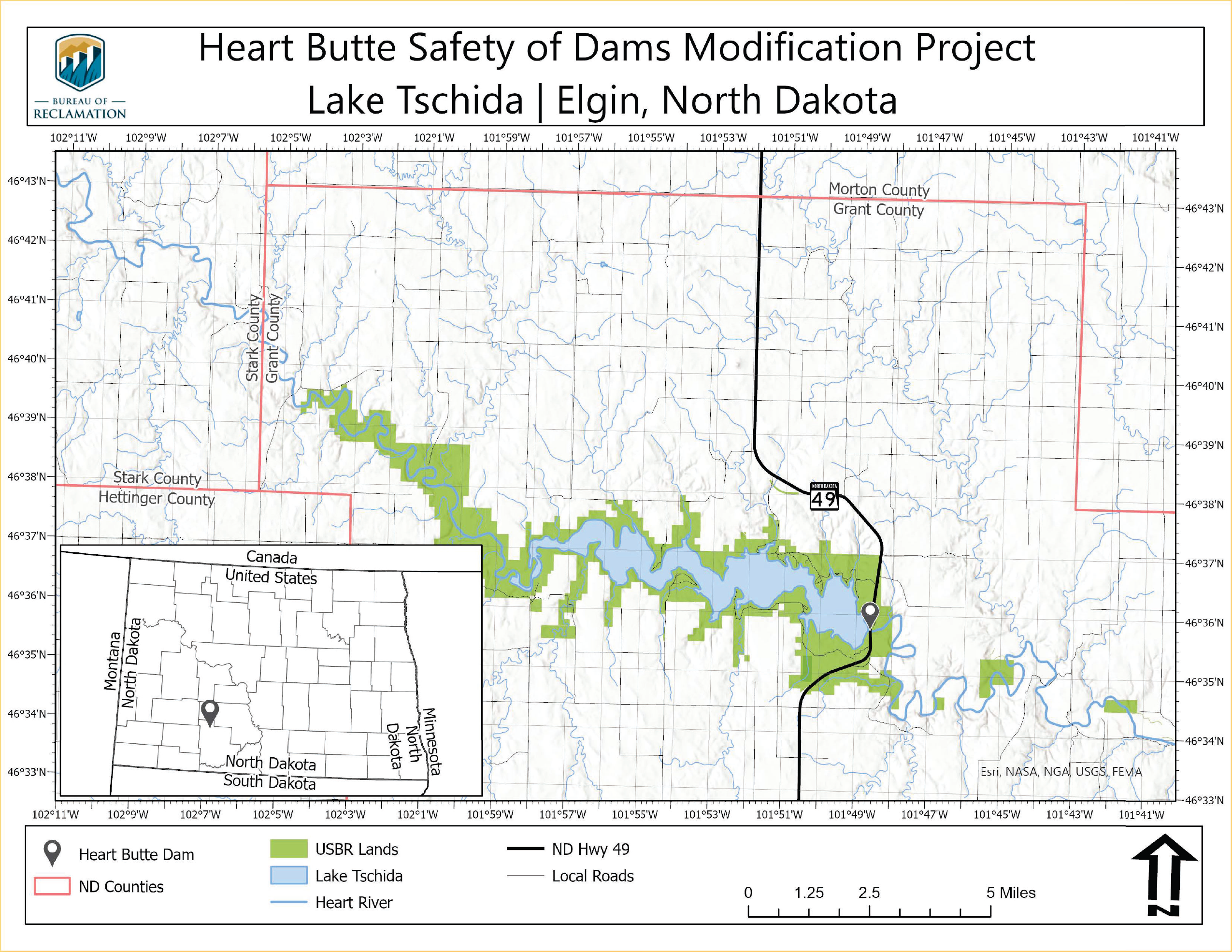- Reclamation
- Missouri Basin and Arkansas-Rio Grande-Texas Gulf
- Dakotas Area Office
- Heart Butte Safety of Dams Modification Project
Heart Butte Safety of Dams Modification Project
Heart Butte Dam on the Heart River in south central North Dakota is a homogeneous earthfill structure completed in 1949. Heart Butte Reservoir (Lake Tschida) currently provides water for irrigation, flood control, recreation and fish and wildlife benefits. The Heart Butte Unit irrigation lies in scattered tracts along the Heart River to the Missouri River. There are approximately 13,100 acres of irrigable land.
History of Conduit SeepageDuring construction in 1949, it was noted that cracks in the three-foot thick concrete outlet works conduit were developing in the transition section near the centerline of the dam. These cracks were monitored during construction and repaired to seal off leakage (Reclamation, 1952). Additional chemical grouting of the cracks was performed in 1953 and no major incidents of seepage carrying embankment material were noted until 2013.
On January 25, 2013, during a routine inspection, fine, gray-colored sand deposits were observed inside the spillway conduit at Heart Butte Dam. Subsequent investigation determined that foundation sand was being transported by seepage through a contraction joint at conduit station 9+62 near the center axis of the dam. In March 2013, the lower portion of the contraction joint was covered with two layers of a geotextile filter fabric that was held in place by a prefabricated stainless-steel plate. This action was considered a temporary repair to prevent further internal erosion of the sandstone foundation into the spillway conduit. However, due to the changed condition, it was postulated that the internal erosion risks had increased, and further evaluation of risk was warranted.
Since 2013, multiple field exploration drilling programs and team risk analyses have been performed to better understand the geology and underlying foundation conditions which drive the risk at Heart Butte Dam. The result of these efforts was a Corrective Action Study (CAS) to “identify and evaluate modification alternatives to reduce the risks of internal erosion potential failure modes associated with various seepage paths in the backfill and the sandstone foundation of the outlet works conduit.”
Purpose and Need
The need for corrective actions at Heart Butte Dam arises from Reclamation’s duty to ensure that Reclamation dams do not present unreasonable risks to people, property, and the environment. At Heart Butte Dam, the persistent seepage issues, both into the conduit and in the relic river channel area, and the lack of an engineered filter contribute to the risk of dam failure. Currently, the risk of dam failure is at an unsatisfactory level and corrective actions are needed to reduce the risk of dam failure.
Proposed Action – Reclamation’s Preferred Alternative Under the Proposed Action Alternative, Heart Butte Dam would be modified to correct safety deficiencies in accordance with the SOD program guidance and CAS recommendations. The Proposed Action, Reclamation’s preferred alternative, will combine two traditional approaches for seepage remediation in embankment dams. This alternative will use both seepage cutoff elements and seepage filtration elements to address the risk of internal erosion. Additionally, the preferred alternative (and all modification alternatives) will include chemical grouting of the conduit joints and foundation void grouting performed from within the conduit. The need for all of these project features is driven largely by the unique single penetrating conduit layout and the potential need for flood management operations during the modification construction period. Reclamation is solely responsible for the preparation of this EA to fulfill the NEPA requirements for this Proposed Action, CEQ Regulations (40 CFR 1500-1508) and related environmental regulatory requirements.
This EA may lead to a Finding of No Significant Impact (FONSI) if impacts are found to be insignificant or, if significant environmental impacts are identified, Reclamation may proceed with the preparation of an environmental impact statement. Reclamation defines significance in accordance with 40 CFR 1508.27 in reference to context and intensity.
Current NEPA documents are available on this same website or upon request by contacting Ashley Persinger at (701) 221-1282 or apersinger@usbr.gov. For additional information please contact Michelle Boehm, Bureau of Reclamation, at (701) 221-1207 or mboehm@usbr.gov.
The signing of the record of decision completes the requirements for the National Environmental Policy Act. The final environmental impact statement was released on Month, date, year, and is available for download in the navigation panel on the right side of this webpage. The record of decision is also available on this same website or upon request by contacting Ashley Persinger at (701) 221-1282 or apersinger@usbr.gov. For additional information please contact Michelle Boehm, Bureau of Reclamation, at (701) 221-1207 or mboehm@usbr.gov.


